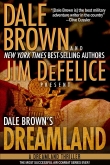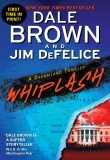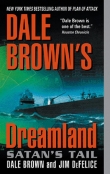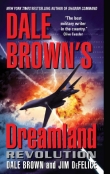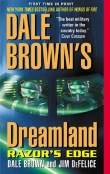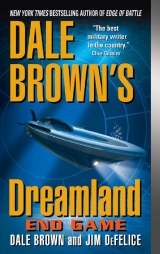
Текст книги "End Game"
Автор книги: Dale Brown
Жанр:
Боевики
сообщить о нарушении
Текущая страница: 5 (всего у книги 22 страниц)
“Hawk One.”
The MiGs, which had been in a close trail, were getting into position to confront the Megafortress. Mack started to follow as Bogey One cut to the east, then realized the plane was closer to Hawk Two.
“I got him, Major,” said Cantor.
“Yeah, yeah, no sweat,” said Mack, swinging back to get his nose on the other airplane.
“If they go for their afterburners, they’ll blow right by you,” warned Cantor.
“Hey, no shit, kid.”
The computer’s tactics’ screen suggested that he start his turn now, recommending that he swing the Flighthawk in front of the MiG to confront it.
“Wrong,” Mack told it. Doing that would take him across the MiG’s path too soon, and he might even lose the chance to circle behind him. Instead, he waited until his MiG began to edge downward. Then it was too late—the Yemen pilot opened up the afterburners and spurted forward, past the Flighthawk, even as Mack started his turn.
“He’s going to use all his fuel, the idiot,” muttered Mack, putting his finger to the throttle slide at the back of the Flighthawk stick. Even so, there was no way he could catch END GAME
79
up with the MiG; it was already flying well over 600 knots.
“They know where we’ll be, Major,” said Cantor. “They can’t see us yet but they learned from the encounters back in November.”
“Big deal,” said Mack under his breath.
CANTOR PULLED HIS FLIGHTHAWK BACK TOWARD THE MEGA-fortress, aiming to stay roughly parallel to the other fighter’s path. The MiG-29 Fulcrum was an excellent single-seat fighter, highly maneuverable and very dangerous when equipped with modern avionics and weapons. But it did have some shortcomings. As a small aircraft, it could not carry that much fuel, and teasing the afterburners for speed now would limit what it could do later. And their limited avionics meant the Flighthawk was invisible to them except at very close range. Guessing where it was wasn’t the same as knowing.
As soon as the Yemen jet turned to try and get behind the Megafortress at close range, Cantor made his move, trading his superior altitude for speed and surprise. He reminded himself not to get too cocky as it came on, staying precisely on course and resisting the temptation to increase his speed by pushing his nose down faster.
“Bogey at one mile; close intercept—proximity warning,” said C3, the Flighthawk’s computer guidance system.
“Acknowledged, Computer,” said Cantor. He gave the stick a bit of English as his target came on. The Flighthawk crossed in front of the MiG in a flash, its left wing twenty yards from the aircraft’s nose. As he crossed, Cantor pushed his stick hard to the right, skidding through the air and lining up for a shot on the MiG’s hindquarters.
He didn’t quite get into position to take the shot, but that didn’t matter. The MiG veered sharply to the west, tossing flares and chaff as decoys in an effort to get away.
“Hawk Two has completed intercept,” Cantor reported.
“Bogey One is running for cover.”
80
DALE BROWN’S DREAMLAND
Off the coast of Somalia
2010
STARSHIP ACKNOWLEDGED THE RADIO CALL FROM THE APproaching Indian destroyer, identifying himself as an aircraft from the Abner Read. He was ten miles northeast of the ship, the Calcutta, too far off for them to realize that the aircraft was too small to hold a pilot.
“Werewolf One, our commander wishes you to pass along a message to your commander,” said the radioman aboard the Calcutta.
“Sure,” said Starship.
“He salutes Captain Gale on his many victories. He hopes that he will have an opportunity to visit the Abner Read in the future.”
“I’ll relay the message,” said Starship.
Starship circled over the Indian warship twice, then began heading back toward the Abner Read, close to 250
miles away. He double-checked the auxiliary screen showing the status of Werewolf Two—the computer was flying the aircraft in a routine patrol pattern around and ahead of the ship—then turned his full attention to the sea in front of him. An oil tanker was about a mile and a half northwest of him, low in the water with its full load.
Something else was there, too—a plane almost in the waves, moving at 100 knots, about five miles north of him.
“Werewolf to Tac,” said Starship. “Hey, check this contact out!”
Indian Ocean
2012
CAPTAIN SATTARI GRINNED AS THE TORPEDO FELL OFF ITS RAIL.
Freed of the weight, the Beriev rose abruptly. Sattari caught a glimpse of his well-lit target five miles off, just beyond the oil tanker. He banked and tucked back closer to the waves, END GAME
81
trying to keep the plane no higher than fifty feet, where it should not be seen by the destroyer’s Russian-made radar system.
It would take the torpedo less than three minutes to run to its target. The destroyer would undoubtedly detect the fish once it cleared the tanker, and take evasive maneuvers when the torpedo was detected. But he’d gotten close enough to narrow the odds of escape; the torpedo was designed to home in on its target, and if the crew aboard the destroyer was not swift, he would score a great victory.
Pointless to even think about it now, he told himself, finding his new course.
“Aircraft!” said his copilot, manning the passive infrared sensors. “Helicopter!”
“Where?”
“Three miles to our southeast.”
“Pursuing us?”
“Uncertain. His radar is operating. He may see us.”
Sattari squeezed the throttle for more power.
Aboard the Wisconsin , over the Gulf of Aden
2014
“MIG TWO CONTINUING TOWARD US AT A HIGH RATE OF
speed,” Jazz told Dog.
“Open the bay doors.”
“He’s not targeting us, Colonel.”
“Bay doors.”
“Bay.”
The rumble of the missile bay opening shook the aircraft.
Dog double-checked his position, then reached to the communications panel.
“Yemen MiG-29, this is EB-52 Wisconsin. You can get as close as you like, but if you get in my way you’re going to swim home.”
82
DALE BROWN’S DREAMLAND
“Big words, yankee-man.”
Dog laughed. “I guess he told me.”
“Ten miles, sir.”
“Relax, Jazz. He just wants to prove his manhood so the rest of squadron will buy him beers.”
“They’re Muslim, Colonel. They don’t drink alcohol.”
“That was a joke. Ease up.”
“I’m trying.”
HAVING BLOWN THE INTERCEPT, MACK TRIED DESPERATELY TO
think of some way to save face as he swung back toward the Wisconsin. He was pretty far out of the picture now, five miles behind the MiG, which was still picking up speed as it came at the Megafortress. If this had been more serious, the bogey would have launched its missiles by now.
Of course, if it had been more serious, the Megafortress would have launched its own antiaircraft missiles.
Game or not, he knew he’d had his fanny waxed, and he needed to get revenge. He watched as the MiG changed course, turning to the west away from the EB-52. The computer, drawing its probable course in the sitrep screen, mo-mentarily showed it breaking off, but it quickly caught on—like its companion, the plane was angling for a high-speed run from behind, a good position to launch heat-seekers.
Mack was too far behind the MiG to follow and too far ahead of the Megafortress to follow Cantor’s strategy and cut the MiG off behind the plane. So instead he began his own turn to the west—he’d make his intercept after the MiG passed the EB-52.
And, just to make the experience special, he’d toss a few flares in the MiG’s face as he went by.
The Yemen aircraft came at the Megafortress at 550
knots, clearly not interested in riding alongside the American plane. This suited Mack perfectly, and he began climbing out ahead of the EB-52, ready to trade the height for speed when he wanted.
END GAME
83
“Hawk Two, what the hell are you doing?” demanded Colonel Bastian.
“Just getting ready to say hello.”
“Stay out of my flight path. I have a job to do here.”
Grouch, thought Mack.
Aboard the Abner Read,
off the coast of Somalia
2015
“THIS LOOKS A LOT LIKE THOSE CONTACTS WE HAD THE OTHER
night,” Starship told Eyes as he scrambled to follow the aircraft he’d just spotted. The slow-moving plane, about five miles north of Starship’s Werewolf, was so low the sensors showed it on the surface of the water.
“Good, copy, we concur here. Track him.”
“Yeah, I’m on that.” Starship swung the Werewolf westward as the bandit continued to pick up speed. The image in the forward-looking infrared showed that the airplane had two engines set high behind the wing; it was small, almost surely a civilian aircraft. The threat file in the Werewolf’s combat computer couldn’t identify it.
Starship followed at about two miles, ratcheting his speed up as the strange aircraft continued to accelerate. Starship tucked his Werewolf downward, trying to get a better look at the underside of the craft. But the other plane was so low to the waves that he had a hard time; he kept jerking his hand involuntarily as the shadows changed on the screen.
Finally he backed off his speed, dipping so close to the water that he nearly ditched.
“Definitely no weapons,” he told Tac. “Looks like a civilian craft. Are you going to contact them?”
“Stand by,” said Eyes, his voice tense.
The distance between the two aircraft had widened to four miles. Starship began to climb and accelerate. As he did, the bandit veered to the east.
84
DALE BROWN’S DREAMLAND
“He’s climbing,” Starship told Tac.
“Werewolf, Indian destroyer Calcutta is reporting it’s under fire. They’ve been torpedoed. Stand by to render assistance.”
“What do you want me to do with this aircraft?”
“He has no weapons?”
“Negative. Look, maybe he launched the torpedo.”
“Way too small for that. We’ll hand him off to Dreamland Wisconsin. Get back over to the Calcutta. They need assistance.”
“Roger that,” said Starship, changing course.
Aboard the Wisconsin , over the Gulf of Aden
2015
DOG STAYED ON HIS COURSE AS THE MIG-29 CLOSED IN BEhind him. If the plane showed any hostility—if it simply turned on the radar used to guide its missiles—he would shoot it down with the Stinger antiair mines in the Wisconsin’s tail. He’d do the same if the aircraft flew as if it would crash into him. But the pilot gave him a half-mile buffer, flying below and off his right wing, close enough to win some sort of bragging rights back home but not quite enough to justify an aggressive reaction.
Dog saw Mack adjusting course to make a pass at the MiG just as it cleared from the Megafortress. Mack cut things considerably closer than the MiG driver did, not only twisting the Flighthawk to within a hundred feet of the Yemen plane, but shooting flares as he did. His timing was a little off, but the other pilot, either confused or panicked, jerked hard to the north and dove a few seconds after the encounter.
Part of Dog thought the Yemen idiot had gotten what he deserved: most likely, a pair of speed pants that needed some serious laundering.
END GAME
85
Another part of him was angry as hell at Mack for acting like a two-year-old.
“Hawk Two, get your nose back into formation.”
“Oh, roger that, Colonel,” said Mack, just about chortling. “Did you see him?”
Luckily for Mack, the commo panel buzzed with an incoming transmission from the Abner Read on the encrypted Dreamland communications channel. As soon as Dog keyed in the communication, the face of Lt. Commander Jack “Eyes” Eisenberg appeared on the screen.
“Bastian, we have a possible submarine approximately two hundred miles south of us. It just launched an attack on an Indian destroyer. We’d like you to help locate it with your Piranha unit.”
“We’re not carrying Piranha,” Dog told him. The undersea robot had not been ready when they took off, and it hadn’t made sense to delay the patrol—facts that Dog had already explained. “Piranha will be aboard the next plane out. We have sonar buoys—we can drop those.”
“Affirmative, good. Also, Werewolf has been following an aircraft just north of there. Airplane appears to be civilian but hasn’t answered any hails. May be a smuggler. We’d like to find out what it’s up to. Send one of your Flighthawks to pursue the aircraft.”
“Bit of a problem there, Abner Read,” responded Dog, doing his best to ignore the sailor’s haughty tone. “The Flighthawk has to stay within twenty miles of us. We can’t be in both places at the same time.”
“I don’t understand. How come the Werewolf can be so far from us?”
“The control and communications systems are different,”
said Dog. “Basically, the Flighthawks are considerably more difficult to fly and require a greater bandwidth than the Werewolf.”
They also represented an older generation of technology—much had changed in the three years since they began flying.
86
DALE BROWN’S DREAMLAND
“All right. Stand by.” The line snapped clear.
“Dish, how close do we have to get to detect a periscope?” Dog asked the radar operator.
“Going to depend on too many factors to give you a guarantee,” Captain Peter Mallack answered. “Specs say we should be able to nail him at fifteen miles, though. Of course, if he’s on the surface—”
“What if he isn’t using his periscope?”
“We won’t find him without sonar buoys, or until Piranha’s operating.”
“Thanks.”
“Bastian, what’s your problem?” snarled Storm, appearing in the communications panel.
“Physics. I can’t be in two places at one time,” said Dog.
“I can look for the sub or inspect your unknown aircraft, but not both.”
“That’s ridiculous—send one of your aircraft after this flight, and then get your butt down south and find this submarine. Drop your buoys. Jee-zus, Bastian. Since when do I have to tell you your job?”
Same old Storm, thought Dog, looking at the captain’s red face.
“The Flighthawks were designed to stay close to the Megafortress,” said Dog, keeping his voice neutral. “I don’t like those limits myself, but we’re stuck with them at the moment. Do you want me to follow the plane or to look for the submarine?”
Storm, apparently interrupted, glanced at someone else on the bridge.
“We can continue to track him with our radar,” added Dog. “Out to about three hundred miles or so, maybe more depending on his altitude.”
Storm turned back to the screen and raised his hand.
“Hold on Bastian, hold on.”
“Hey, Colonel, I have the aircraft on the viewscreen,”
said T-Bone over Wisconsin’s interphone. “Computer can’t ID it, but it’s about the size of a Cessna. Two engines.”
END GAME
87
“You think there’s a possibility that plane launched a torpedo?”
“Doesn’t look big enough. Hard to tell from here, but guessing from the size of the engines and given his speed, I doubt he could have taken off with it. You might have a better idea.”
“Doesn’t look likely,” said Jazz, who’d brought up some of the data on his screen. “If it’s a smuggler, he might have been working with that tanker. Might be a seaplane.”
“I’m not positive it’s a seaplane,” said T-Bone.
“Thanks. Stand by.”
He glanced at the video screen at the lower left of his control panel. Storm was still busy, so Dog used the circuit to talk to Starship. “Wisconsin to Werewolf One. Starship, this is Colonel Bastian. How are you?”
“Busy, Colonel; just coming up to the Indian destroyer now. But OK, sir.”
“Can you give us anything else on that aircraft? Was he aboard that tanker? Next to him? Had he been in the air and en route south?”
“Don’t know on any of that, Colonel. I’m sorry.”
Starship broke to answer a communication from the destroyer; Dog heard him being directed to the starboard side of the ship, where the destroyer had several men in the water.
“All right, Werewolf One,” said Dog. “Contact us when you get a chance.”
“Werewolf,” said Starship quickly.
“Bastian?”
“Yes, Storm. Go ahead.”
“Concentrate on the submarine. Where’s the Piranha?”
“The aircraft carrying it will be taking off in about an hour.”
“Hurry it up. Get it over there ASAP.”
“Roger that.” Dog switched over to the interphone.
“T-Bone, continue to track that aircraft Werewolf was after.
Update me every few minutes.”
88
DALE BROWN’S DREAMLAND
Aboard the Abner Read,
off the coast of Somalia
2018
STARSHIP COULD SEE THE INDIAN DESTROYER LISTING HEAVILY
to its starboard side as he approached. The torpedo had exploded close to the hull, but either by deft maneuvering or good luck, the Indian warship had sustained only a glancing blow. That was still enough to do heavy damage, however, and the crew was working feverishly to block off sections of the ship that were being flooded.
The Werewolf’s searchlights made small circles on the foaming waves near the crippled ship. A small boat had disembarked from the destroyer and was approaching the area.
Starship dropped the robot aircraft into a hover, concentrating on illuminating the area near the boat.
The Indian ship radioed to ask that he move toward the bow of the destroyer. It took a few seconds for Starship to understand what the radioman was saying through his accent.
“Roger that. Moving toward bow.”
Large bits of debris floated near the ship. The Werewolf’s search lamps caught a twisted pipe sticking out from the side of the ship, an obscene gesture directed back at whoever had attacked it.
Something bobbed at the far right of his screen, just outside the area he was illuminating. He nudged the stick, moving the robot helo toward it and zooming his optical video feed to full magnification.
A head bobbed in his screen.
“Calcutta, I have something,” he told the destroyer.
“Have the boat follow my beam.”
He waited anxiously, lights trained on the seaman. The boat reacted in slow motion. Starship lost sight of the man for a second and started shouting. “Get over there, damn it!
Get over there! Get him before he drowns! Come on!
Come on! ”
As the prow of the rescue boat came into view, the head END GAME
89
bobbed back up. Starship saw someone in the boat reaching with a pole, but the man in the water didn’t take it. The boat got closer; one of the sailors leaned out toward the stricken man. Starship kept the Werewolf steady, trying to stay close enough to give them plenty of light but not wipe them out with the wash of the rotors.
The man in the boat grabbed the stricken sailor by the back of the shoulders. He hauled him into the boat.
Starship’s eyes were glued to the screen. He saw the head coming out of the water, and then the arms and the top of the man’s back—and nothing else.
The man had been severed in two by the explosion.
Bile ran up Starship’s throat. He threw his hand over his mouth but it was too late; some of the acid spurted out over his shirt. Eyes tearing, he tried choking it back down, struggling with his other hand to control the Werewolf.
STORM PACED THE BRIDGE, ANXIOUS TO GET HIS SHIP SOUTH.
The Abner Read was built for stealth, not speed; still, she could touch forty knots, a good speed for a small craft.
Right now she was doing 38 knots. Even if they held that speed, it would take roughly five hours to reach the destroyer.
“I’m going out for some air,” he told the others. Then he walked out onto the flying bridge at the side.
No more than a platform that could be folded into the superstructure, the design of the flying bridge had been carefully calculated to have minimal impact on the Abner Read’s radar signature. Not only was it the highest point on the low-slung ship, but it was one of the few dry and flat surfaces outside. The main deck sloped down and was often lapped with waves.
The salty breeze bit Storm’s cheeks. The wind was coming up and he felt a chill. But it was a good chill, the sort of wind that reminded him why he’d wanted to join the Navy in the first place.
The aircraft the Werewolf had seen near the oil tanker bothered him. It seemed similar to the ones they’d spotted 90
DALE BROWN’S DREAMLAND
the night Port Somalia was struck. If it had been a little bigger, he supposed, it might have launched the torpedo itself.
Maybe it was working with the submarine that made the actual attack. Or maybe the tanker.
There’d been a tanker nearby when he lost the other submarine as well. This was a different ship, but the parallels had to be more than a coincidence.
Didn’t they?
The submarine might be the same vessel he had chased the other night, able to hide along the coast because its clever captain knew the waters so well. A Chinese Kilo, maybe.
But then what was the aircraft doing? Was it Chinese as well?
Storm decided the submarine was the key to the mystery.
He would find it and then—since he couldn’t attack—he’d give the exact location to the captain of the Indian destroyer, who no doubt would be anxious for revenge.
Assuming his ship didn’t sink before then.
Storm allowed himself one more deep, luxurious breath of air, then went back inside.
Aboard the Wisconsin , over the Gulf of Aden
2045
DOG NUDGED THE MEGAFORTRESS INTO POSITION TO LAUNCH
the first sonar buoy twenty miles north of the stricken destroyer. The Megafortress would set a large underwater fence around the area, waiting for the sub to make its move.
“What’s the destroyer’s situation?” Dog asked Jazz.
“Nothing new,” said the copilot. “Still fighting the damage. They’ve had a couple of sonar contacts but they seem to have been false alarms.”
As Dog and Jazz launched the buoys, Dish searched for the submarine’s periscope. A half hour later they had covered every inch of the target area without finding anything.
END GAME
91
“Best bet, he’s sitting down about three hundred meters, just about as low as he can go, holding his breath and waiting for the destroyer to limp away,” said Jazz.
“He’ll be waiting a long time.”
“He won’t get by the buoys without us knowing.”
Dog wasn’t so sure about that. In theory, the hunters had all the advantages—the buoys could find anything in the water down to about 550 meters or so, and an extended periscope or snorkel could be easily detected at this range.
But the reality of warfare was never quite as simple as the theory, especially when it involved a submarine. Dog had worked with the Navy on sub hunts before, and they were always complicated and tricky affairs. In NATO exercises, submarines routinely outfoxed their hunters.
“Just a waiting game now, Colonel,” said the copilot.
“We’ll get him eventually. We just have to be patient.”
“For some reason, Jazz, being patient has always seemed the hardest thing to do,” Dog said.
Approaching Oman on the Saudi Peninsula 2145
CAPTAIN SATTARI FELT THE SWEAT ROLLING DOWN HIS ARMS
and neck. His clothes were so damp it seemed he’d been out in the rain. He was cold, and in truth was afraid, sure that he was being tracked by a powerful American surveillance radar, positive that some unseen fighters were scrambling along behind him to take him down. Every bit of turbulence, every vague eddy of air, sent a new shiver down his spine. He had the engines at maximum power; the airspeed indicator claimed he was doing 389 knots, which if true was at least thirty miles an hour faster than the engineers who made the plane had said was possible. But it was not nearly fast enough.
“We’re at the way point,” said his copilot.
“Yes,” said Sattari, and he moved his aircraft to the new course. Oman loomed fifteen miles ahead.
92
DALE BROWN’S DREAMLAND
If I can make it to the twelve-mile limit, he told himself, then I will be OK. In the worst case, if the Americans pressured the emir, they could blend in with the civilian government and escape.
Sattari scolded himself for thinking like a defeatist, like a refugee. He tightened his grip on the plane’s wheel, flying.
The surveillance plane must be far away, or surely it would have tried to contact him by now.
Unless it was vectoring fighters to intercept him. Or planning to alert the authorities on shore.
Oman was not as friendly toward the Americans as it once had been, and was unlikely to cooperate. Still …
“Two minutes to the landing, Captain,” said his copilot finally.
The radar warning receiver switched off. They were no longer being watched—or was it a trick to make him think that?
Even when he saw that the landing area was empty, Sattari was not convinced he wasn’t being followed. He taxied to the dock, then turned the plane around to make it easier for his copilot to get out and handle the refueling.
“Hurry,” he told the copilot as he feathered his propellers. “I wish to take off as soon as possible.”
“Is that wise? Shouldn’t we wait a day or two?”
“No. If we are no longer being followed, it is best to leave right away. And if we are being followed, there is no sense delaying the inevitable.”
Aboard the Abner Read , off the coast of Somalia
9 January 1998
0111
STORM STUDIED THE INDIAN DESTROYER WITH HIS NIGHT
glasses, examining the damaged ship from about a quarter of a mile away. The Calcutta listed six degrees to END GAME
93
starboard—a serious lean, as Airforce put it when he described the situation earlier. But the damage had been contained. The Indian ship no longer appeared in danger of going to the bottom. More than twenty of her men had been killed or were still missing, another thirty or so injured.
With a crew of forty officers and 320 enlisted, the Calcutta displaced 5,400 tons, a good 1,200 less than a member of the U.S. Navy’s Arleigh Burke Block I class, a rough contempo-rary. The Indian ship was a member of the Delhi class, a guided missile destroyer that used both Russian and western components and weapons system. A 100-millimeter gun sat on her forward deck just about where the torpedo had exploded.
The antisubmarine torpedo battery aft of the gun had caught fire immediately after the strike and now sat charred and mangled at the side, a cat’s claw of burnt metal. Storm guessed that the Indians’ own weapons had caused many of the causalities.
“Corpsmen are ready to disembark,” said the crewman in the Abner Read’s fantail “garage.”
“Proceed,” said Storm.
A panel in the well of the ship’s forked tail opened and a rigid-hulled inflatable boat sailed out and sped toward the stricken destroyer, carrying medicine and two corpsmen to help the Indians. Once the men were safely aboard, the Abner Read would head eastward after the Pakistani oil tanker, which was now about fifty miles away.
Unless he could spot the submarine first.
“Eyes, what’s the status of our treasure hunt?”
“Nothing, Storm. Submarine is nowhere to be found.”
“What about Piranha?”
“It’s been in the water two hours now without a contact.”
Impossible, thought Storm. Impossible!
He thought of punching the bulkhead in frustration.
Then, realizing he was only thinking about it, he smiled at himself. He had changed in the past few months.
“Keep on with the search,” he told Eyes. “Tell the Dreamland aircraft controlling Piranha that we’ll be heading for that oil tanker within a few minutes.”
94
DALE BROWN’S DREAMLAND
Las Vegas University of Medicine,
Las Vegas, Nevada
1530
ZEN ROLLED HIMSELF OFF THE ELEVATOR INTO THE LOBBY AND
saw his taxi waiting outside. He was glad: Despite the fact that he’d spent the day doing almost absolutely nothing, he felt exhausted.
The needles were already routine, as were the monitors, scans, and tepid herbal tea offered up by Dr. Vasin’s interns in place of their overheated coffee. The light exercises they gave him to do with dumbbells were a bare shadow of his normal daily routine. So why was he so tired?
Partly because he wasn’t sleeping. He missed Breanna, and found it difficult to sleep without her.
And he continued to have the dream. It distracted and annoyed him, kept him guessing what it was really about.
Better that, though, than worrying about whether the experiments were actually going to do anything. So far, he felt exactly the same.
“I’ll get the door for you, sir,” said a young man, trotting ahead as he came down the hall.
Zen stopped. The kid was just being polite, but his goofy smile irked him. Zen forced a gruff “Thank you” as he rolled past.
Aboard the Islam Oil Princess , in the Arabian Sea
0350
A LIGHT SPRAY OF SEAWATER WET STORM’S FACE AS THE
rigid-hulled inflatable drew close to the Pakistani oil tanker.
The first boat had already deposited most of the shipboard integrated tactical team, and the SITT members were fanning out above.
The tanker’s crew and its captain were cooperating, but END GAME
95
Storm wasn’t taking any chances. The Werewolf, with Starship at the controls, hovered overhead. The aircraft’s floodlights made it look like one of the riders of the Apocalypse, the gun at its nose a black sword as it circled menacingly around the forecastle.
Storm had decided he would go aboard personally, partly as a gesture of respect to the other captain, and partly to show him how seriously they were taking the matter.
“Secure, sir,” said the ensign in charge of the landing team, speaking over their short-range communications system.
“Very good,” said Storm. He’d exchanged his shipboard headset for a tactical unit, which had an earset and a mike clipped to his collar. He didn’t bother with the helmet most of the boarding party wore, though he did have a flak vest on. “I’ll be aboard shortly.”
Storm checked back with Eyes as he waited for the boat to draw alongside the tanker.
“No sign of the submarine at all,” Eyes said. “Piranha has gone to silent mode, just waiting. If it’s nearby, she’ll hear it when it moves out.”
“Keep me informed. Storm out.”
The petty officer who headed the boarding team in Storm’s boat leapt at the chain ladder on the side of the tanker as they drew near. He pulled himself up two rungs at a time, leading his team to the deck.
This is the way my crew operates, Storm thought, following. A seaman from the Abner Read met him at the rail and helped him over, then led him up to the tanker’s captain, waiting with Storm’s ensign on the bridge.
At nearly seven feet tall, the captain towered over Storm.
A rail of a man, he gripped Storm’s hand firmly when they were introduced.
“You were near the Indian destroyer when it was struck by a torpedo,” said Storm, dispensing with the preliminaries. “Why didn’t you stop?”
96
DALE BROWN’S DREAMLAND
“They did not ask for our assistance.” The Pakistani’s English was good, his accent thin and readily understandable.
“You saw the submarine?” asked Storm.
“No. We did not understand what happened. It was only your man here who told me that the ship had been fired on.

